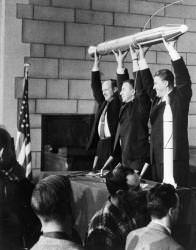The launch of Sputnik in October 1957 changed the world overnight. And with the Soviet Union's second successful launch of Sputnik 2 the following month, Americans were feeling a little left behind in the dust, especially after the US's first satellite launch attempt with the Vanguard rocket exploded on the launchpad. But space pioneer Werner Von Braun, shown in this picture with JPL Director William Pickering and scientist James Van Allen, came through with his Jupiter C rocket that launched the US's first satellite, Explorer 1, into space on January 31, 1958.
Explorer 1 was not all that big, with a length of 203 centimeters (80 inches), a diameter of 15.9 centimeters (6.25 inches), and a weight of 14 kilograms (30.8 pounds). But it did its job, which was, first and foremost, to reach orbit, and then return scientific information.
The Jet Propulsion Laboratory got the assignment of designing and building a scientific payload for the launch, which they accomplished in three months.
The primary science instrument on Explorer 1 was a cosmic ray detector designed to measure the radiation above the atmosphere. Dr. James Van Allen designed the experiment, which revealed a much lower cosmic ray count than expected. Van Allen theorized that the instrument may have been saturated by very strong radiation from a belt of charged particles trapped in space by Earth's magnetic field. A subsequent launch by Explorer 3 two months later confirmed the existence of these radiation belts, which became known as the Van Allen Belts, in honor of their discoverer.
There were other scientific findings from Explorer 1 as well. Because of its symmetrical shape, Explorer 1 was used to help determine the upper atmospheric densities.
Two other instruments on board looked for micrometeorites in orbit: a micrometeorite detector and an acoustic microphone to detect the sound of an micrometeorite impact. The micrometeorite detector was made of a grid of electrical wires. A micrometeorite of about 10 microns would fracture a wire upon impact, destroy the electrical connection, and record the event. One or two of the wires were destroyed during launch. The equipment worked for about 60 days, but showed only one possible meteorite impact. Data from the acoustical sensor microphone were obtained only when an impact occurred while the satellite was over a ground recording station. However, over an 11-day period (February 1, 1958, to February 12, 1958), 145 impacts were recorded. The high impact rates on one portion of the orbit and the subsequent failures in the satellite's electronic system were attributed to a meteor shower.
The batteries ran out on Explorer 1 on May 23, 1958 when the last signal was recorded. The US's first satellite burned up in re-entry of the atmosphere in March of 1970.
Original News Source:
Explorer 1
 Universe Today
Universe Today
